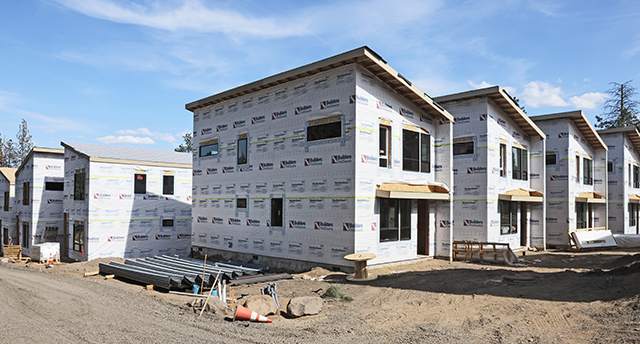Oregon wants fewer nursing home beds
Published 12:00 am Friday, January 17, 2014
State officials are asking nursing homes to reduce their overall capacity by 1,500 beds over the next two to three years as part of a plan to make the most intensive and expensive part of Oregon’s long-term care system more efficient and bring it in line with customer demands.
“Right now, Oregon has the lowest nursing home occupancy rate in the country,” said Michael McCormick, deputy director of Oregon’s Aging and People with Disabilities Program, the state agency that supervises long-term care.
McCormick warned that “the low utilization of nursing home facilities is not sustainable in the long-term” and said the state’s new policy will give Oregon’s 139 nursing homes a reason to become more efficient and reduce costs.
Most of them are covered by publicly funded health plans such as Medicare and the Oregon Health Plan.
If the state’s nursing homes fail to make the reduction by July 1, 2016 — a goal one administrator said shouldn’t be tough given the recent shift in the industry — the facilities will see a reduction in what they’re paid for their services.
The facilities
According to the Aging and People With Disabilities website, Oregon’s nursing homes provide care in a hospital-like environment to some of the most fragile elderly residents who need help performing basic daily activities.
“(Our residents) need someone to help them with just about everything,” said Tom Hathaway, administrator for the Pilot Butte Rehabilitation Center, one of four state-licensed nursing homes in Deschutes County.
In order to provide care, Hathaway said nursing homes must comply with the strict staffing guidelines in the state’s long-term care system, which also include small adult foster homes, assisted-living facilities, and home care providers.
The state’s administrative rules require nursing homes to have at least one licensed nurse on duty 24 hours a day — even while residents are asleep — and one certified nursing assistant on duty for every seven to 18 residents, depending on the time of day.
Because of staffing levels, nursing homes are the most expensive part of the state’s long-term care system, costing between $7,057 and $7,726 a month, according to the U.S. Department of Health and Human Services.
The federal and state government picks up a lion’s share of this bill, according to a report by the Henry J. Kaiser Family Foundation that found Oregon’s Medicaid program, the Oregon Health Plan, was the primary payment source for 60 percent of Oregon’s nursing home residents.
Medicare was the primary payment source for 14 percent of the state’s nursing home residents, according to the report. Under the federally funded health-care plan’s rules, Medicare beneficiaries can only stay at a nursing home for 100 days — most often to recover from a serious injury or a hospital stay — after which they are responsible for all nursing home costs.
While nursing homes used to be the dominant place where elderly people went for their long-term care needs, both McCormick and Hathaway said over the past few decades there has been a shift toward less expensive ways of providing care.
This shift, which McCormick said has closely paralleled the growth of Oregon’s home-based care industry, has led to a reduction in the number of nursing home patients and a general shift in a nursing home facility’s overall mission and purpose.
According to the foundation’s report, Oregon’s nursing homes had an overall occupancy rate of 61.4 percent in 2011. The national average was 83 percent while California, Idaho and Washington had occupancy rates of 84.9 percent, 69.8 percent and 80.4 percent, respectively.
McCormick said the state’s low nursing home occupancy rate — which varies from region to region and facility to facility — means the state is essentially paying the facilities to maintain and provide the upkeep for a considerable amount of empty beds or rooms.
“My facility has 100 licensed beds but our daily census runs between 30 and 35,” said Hathaway, whose facility had an occupancy rate of 32.1 percent last year, the lowest for a Des-chutes County nursing home (see “Nursing home occupancy rates”).
Out of the 30 to 35 people who stay at his facility on a given day, Hathaway said only 12 of them are residents for long-term care services. The remaining 20 to 25 people are patients in need short-term rehabilitative care who will go home after a couple months.
McCormick said he’s seen a similar resident-to-patient ratio at nursing homes across the state.
That’s because Oregon is quickly becoming a leader in the development of home-based health care services and smaller facilities like adult-foster homes — which provide care to no more than five people at once — that provide long-term care outside the nursing home environment.
“That’s where the market is going,” McCormick said, explaining he expects this trend to continue into the future because baby boomers — who will need long-term care in the next 20 to 30 years — have expressed a similar preference for their personal long-term care desires.
“Oregon has such a great structure for home-based care providers that they are becoming dominant,” he added. “And that means nursing homes are repositioning themselves (from being long-term care providers) to being post-acute care providers.”
The reduction
Because of this shift in the market and the state’s low occupancy rates, McCormick said state officials worked with industry representatives last year to craft a carrot-and-stick approach that would get them to reduce the size of their facilities and reduce their cost to taxpayers.
This approach and the 1,500-bed reduction target it sets out to achieve was laid out in House Bill 2216, a piece of legislation updating the state’s nursing home rules that cleared the Oregon Legislature in the spring.
Under the proposal, the state’s Department of Human Services will pay nursing homes with a clean record — they have not been cited for abuse in the past six months — a bonus of up to $9.75 per resident per day if they voluntarily take steps to trim their capacity.
“We can’t make anyone do anything,” said McCormick, who hopes this bonus will be enough of an incentive to get nursing homes to comply.
But just in case it isn’t, McCormick said the proposal allows the state to start reducing its Medicaid reimbursement rates for the nursing home system in case it’s 1,500-bed goal is not met by July 1, 2016.
The fewer rooms they have cut back, he said, the lower rate they will receive and the less money they’ll be paid for their services.
“For us to reduce our capacity in Central Oregon shouldn’t be too tough,” Hathaway said. He says half of his facility’s licensed beds are in an area that needs a significant amount of renovations anyway.
Though he did have a few objections to the state’s plan, including that with this policy, the state was interfering with a private institution’s ability to make money.
Given the nursing home industry’s already competitive nature and the declining demand for its services, Hathaway said he’s worried about how the state’s nursing homes will reach this goal and whether doing so will give one facility an advantage over another.
He said that while most boomers and seniors today resist the idea of receiving long-term care from a nursing home, they may reach a point where they’ll need one. If the industry got too small, he said, these people would be left without any other care options.
— Reporter: 541-617-7816, mmclean@bendbulletin.com






